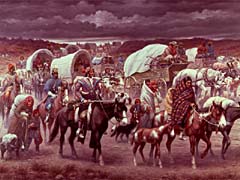The Trail Of Tears

Image Credit: The Granger Collection, New York. Painted by Robert Linden in 1942.
I’ve been working on a story featuring a woman left alone with her children while her husband fights the Civil War and an Ojibwa indian who befriends her. I’m setting the book in the hills of Southern Ohio in the early 1860s, which led me to the question of what Native tribes had been in this region and when they left. My research led me to a devastating period in American history–one whose ramifications are still being felt today.
Prior to the 1800s, the land east of the Mississippi was populated by native tribes. In what is now the midwest, the Potawatomi, Sauk, Fox, Shawnee, Winnebago and Erie tribes roamed. Further east, Mohican, Delaware, Susquehannock and Powhatan tribes were being squeezed off their lands as more and more settlers arrived from Europe. The Black Hawk War in 1832 removed the northern Indians, opening millions of acres in what is now Illinois and Wisconsin.
In the early 1830s, nearly 125,000 Native Americans lived on the land that is now Georgia, Tennessee, Alabama, North Carolina and Florida—land that these Natives had occupied for years. It was thought a solution to the Indian problem was to “civilize” these natives. They were forced to learn to speak and read English, adopt Christianity, and to adopt the economic practices of the Europeans as their own. Many of the Seminole, Creek, Choctaw, Chickasaw, and Cherokee tribes did what the nation requested, and became known as the Five Civilized Tribes. The migration of the American Indian began as a trickle in the early 1800s, as more white settlers began to covet the land these Indians had lived on for centuries. When gold was discovered in Georgia, possession of the land became an overriding concern for the American government,
As tempers flared, more of the east coast Indians migrated voluntarily and settled in the west. However, by the 1830s, the Cherokee nation was a sophisticated group of individuals who were in command of their rights. President Andrew Jackson had ordered for the removal of all tribes east of the Mississippi. Rather than go on the warpath, the Cherokees took the government to court. In the Cherokee Nation vs. Georgia, the Supreme Court ruled for Georgia, but another trial a year later, Worcester vs. Georgia, affirmed Cherokee sovereignty.
President Jackson defied the court’s decision and ordered the removal, using the Treaty of New Echota to justify their actions. New Echota was the capital of the Cherokee nation from 1825 until the 1830s. This treaty,
signed by 100 Cherokees in 1835, relinquished the rights to Cherokee land east of the Mississippi in exchange for money, livestock, tools and provisions. These 100 Cherokee upstarts signed their own death warrants by signing the petition, since tribal law called for the death of anyone agreeing to give up tribal land.

Memorial at New Echota, Georgia, where The Trail Of Tears began.
The treaty, as unsound as it was, was the basis for the removal of 17,000 Cherokees. In 1838, The tribe was rounded up at gunpoint, forced into stockades while their land and possessions were confiscated and then loaded onto boats that traveled through the rivers of Tennessee, Ohio, Mississippi and Arkansas into Indian territory, which is now Oklahoma. The route was 1,200 miles long, much of it accomplished on foot.
Nearly 4,000 died during the migration, from hunger, exposure and illness, leading to the name The Trail of Tears.

http://www.cherokee.org/AboutTheNation/History/TrailofTears/ABriefHistoryoftheTrailofTears.aspx
https://en.wikipedia.org/wiki/Trail_of_Tears
http://www.pbs.org/wgbh/aia/part4/4h1567.html
http://www.history.com/topics/native-american-history/trail-of-tears
Good article. Did you find the hair thingamajiggers?
Patty
>
LikeLike
Got ’em. And thanks for the pat on the back.
LikeLike
Ah yes, Good old Andy Jackson. This was not our country’s finest hour! The great tribes of the south were devastated. Even Ohio wasn’t spared. I’ve read that the Wyandot of northern Ohio were the last to go in 1843. The Ojibwa lingered in Michigan a lot longer even in southern Michigan.
LikeLike
I’d often wondered about the Ohio tribes and when they left. Thanks for the input, Caroline.
LikeLike
Liked this article. I have my Melungeon in Wildwood Flower following parts of the Trail of Tears. Incredible the genocide Americans perpetrated against the Indians. The couple were headed to California for the ’49 Gold rush and one article I found said only 1 out of 5 of the native Americans were alive two years after the miners reached California. Often wonder how reliable such statistics are, but horrible if true.
LikeLike
I can’t get over the depth of your research. Always the teacher. Another great history blog.
LikeLike
Great post, Becky! My mother’s family in northern Georgia always hid our Cherokee ancestry. My mother said they were ashamed of it. I have a different theory. Since my family has been in that area since before the Cherokee removal, I think my family hid their connection since families were being split up along ethnic lines. Intermarriage was very common during the late 18th and early 19th centuries in the South. The Cherokee relatives were sent to OK. The white family members could stay where they were. That which becomes a secret within a family often evolves into shame. It was a very sad period in our history, indeed!
LikeLike
The stories of the tribes vary according to the nature of their removal—war, cession, purchase, fraud—but the experience was awful. In the 20th Century this was repeated in Turkey and Greece in the 20s and in Eastern Europe after 1945.
LikeLike
Pingback: Living History: Connecting to Heritage, Part I | History Imagined